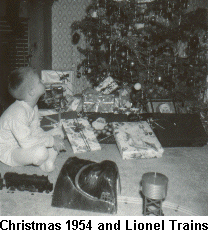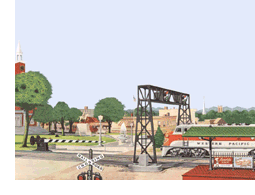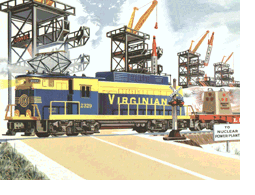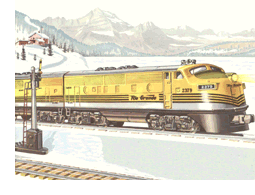The History of the Post War Lionel Screen Saver
 I suppose that I’m similar to many others of my generation who grew up with Lionel trains. There was never quite as great a feeling as opening that Lionel box on Christmas morning. I suppose that I’m similar to many others of my generation who grew up with Lionel trains. There was never quite as great a feeling as opening that Lionel box on Christmas morning.

Although, it was only a "Scout Set" with an American Flyer tunnel and a Marx water tower, to me, these were the greatest trains in the world!
Over the years I’ve felt that I owe a debt to Lionel for interesting me in what has become a life-long hobby. Model railroading to me has always been the most challenging of hobbies because it involves artistry and knowledge from many different fields.
 Creating "The Post War Lionel Screen Saver" was, in my small way, a means to repay some of that debt, and also, to enrich the lives of others who grew up with these trains.
Over seven years ago I started to create pictures on my computer mainly as "wallpaper" for a "Lionel Theme" that I was making for my own use. These pictures came out so well that I began to do others. At the same time I was developing the "Lionel Trains Horizontal Rules" on the web as a means of perfecting my expertise in graphical programs. Creating these "Rules," (used by web page developers) from scratch was a challenge, but I knew they were not nearly as complex as what I wanted to do with the pictures that were in the Lionel catalogs.
I knew that it was always the artwork in the post war catalogs that made Lionel trains so appealing. And it was this artwork I was trying to re-create in digital form on the computer with the trains "center stage." Some of the pages in the catalogs, however, just wouldn’t cooperate. There were the, "operating illustrations," "transformers," "separate sale blocks," "magne-traction symbols," and other items that covered up the trains and the artwork.
I was aware that if I was going to change these paintings I was going to have to work with "print quality" pictures, and that meant I had to have these pictures in my computer at 300 dpi (dots per inch) resolution. The resulting file size from this resolution meant that every picture that I created was over 25 MB (million bytes) in size. And because my computer at that time had only 64 MB of memory it often crashed as I tried to transfer these pictures from the catalogs.
 I started out with one of my favorite catalog paintings. It was one of those that Lionel used in the other publications, but it was always partially obscured by various illustrations for their operating accessories, and was first shown on page 30 and 31 of the 1953 catalog. This picture, so typifies "small town America" in the 1950’s that I really wanted a copy of it. I removed all of the illustrations that covered it and proceeded to recreate that artwork that was behind them. This amounted to about half of the painting. It took me over 75 hours of work to accomplish this but I learned quite a bit doing it, and future pictures would (with only one exception) not take as long to create. I started out with one of my favorite catalog paintings. It was one of those that Lionel used in the other publications, but it was always partially obscured by various illustrations for their operating accessories, and was first shown on page 30 and 31 of the 1953 catalog. This picture, so typifies "small town America" in the 1950’s that I really wanted a copy of it. I removed all of the illustrations that covered it and proceeded to recreate that artwork that was behind them. This amounted to about half of the painting. It took me over 75 hours of work to accomplish this but I learned quite a bit doing it, and future pictures would (with only one exception) not take as long to create.
 In addition to problems inherent in the paintings themselves, was the problem of adapting catalog sized pictures to the "four to three" ratio -- width to height, needed to fit the pictures, full size, on the computer monitor. This meant that all seven and a half million pixels on each picture would have to be moved to prevent distortion of the original painting. In addition to problems inherent in the paintings themselves, was the problem of adapting catalog sized pictures to the "four to three" ratio -- width to height, needed to fit the pictures, full size, on the computer monitor. This meant that all seven and a half million pixels on each picture would have to be moved to prevent distortion of the original painting.
This problem is best illustrated in the painting of "The Virginian Rectifier" that appeared on page 24 of the 1958 catalog. Here, I was faced with adding additional space at the bottom and creating far too much "road," or expanding the "No. 175 Rocket Gantries" higher into the sky. This would be more difficult to accomplish, but would make the composition of the picture much better. Confronted with learning new graphic techniques that I had never used before, this was simply a matter of trial and error until I obtained the best quality picture.
 Other paintings in the catalogs showed marvelous illustrations of the trains on just a blank page. The "Rio Grande F-3" as illustrated on page 35 of the 1958 catalog was a perfect example of this. To make the painting more appealing I brought in the entire background from page 34 and resized it to fit the computer monitor without distorting the scenery. There were many other pictures from the catalogs in which similar graphics were created or brought in to enhance the original artwork that was on the page(s). Other paintings in the catalogs showed marvelous illustrations of the trains on just a blank page. The "Rio Grande F-3" as illustrated on page 35 of the 1958 catalog was a perfect example of this. To make the painting more appealing I brought in the entire background from page 34 and resized it to fit the computer monitor without distorting the scenery. There were many other pictures from the catalogs in which similar graphics were created or brought in to enhance the original artwork that was on the page(s).
 As I adapted these pictures to the digital media my overriding concern was to maximize the quality and at the same time preserve the original intent of the artwork. To that end, I have corrected all of the printing faults that were in the original catalogs and enhanced many of the features of the trains that were not visible to the naked eye in these catalogs. Creating these pictures has taken over two years of solid work.
We’ve looked all over the net for screen savers about Lionel Trains and there is just nothing available that compares with what I have created. Perhaps this is because creating these pictures really has been a labor of love.
 |



